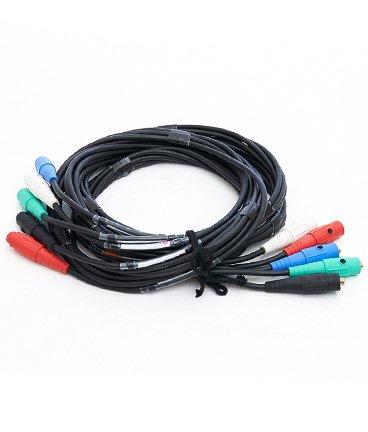Electrical Basics
Calculating electrical loads is an easy math equation:
Watts = Amps x Voltage
Here are the elements explained:
Wattage (watts) is a measure of total energy used by an electrical component, in this case a light. Most of our lights are rated by wattage, and it is usually the name by which we refer to them. A 150 (pepper) consumes 150 watts, a 300, 300 watts. The 1.2K HMI consumes 1200 watts, etc. The Kinos are one of the exceptions to this rule. They draw varying amounts of power, since each of the 4 banks can be lit independently. Each of the bulbs of a Kino uses about 165W, drawing 1.4 amps (5.5A total draw for all 4 blubs).
Amperage (amps) is the draw of electricity. This is best described as the rate of flow, similar to how a river works. At any point across a river you can measure the cubic litres of water moving past you, based on the width and depth of the river at that point. Amps represent the total flow of power at a given point in a circuit.
All breakers are based on amperage, and rated as such. In practical terms amp rated breakers are a measure of the maximum amount of energy which can pass safely through that circuit. Common household breakers are usually 15 Amps. 20 Amp breakers are also normal for some higher draw plugs. Utility plugs, such as a stove or drier will often be ganged on two 30 amp breakers for a total power rating of 60 amps. This is the case of the utility plugs in the studio. Vintage breaker or fuse boxes may have lower amperage ratings. The bottom line is to always check the breaker box and confirm breaker values before setting up lights in a new location. Be sure to always map the plugs and know what amperage ratings you are working with.
LEDs help mitigate the problems traditional high amperage draw lights create, but they aren't completely immune to them!
Voltage (Volts) can be thought about as the amount of force possible in a circuit, or the amount of force needed to drive an electric device. To return to the river analogy, voltage would be equivalent to the strength of the current pushing against an object (as opposed to the amount of water present). For our purposes voltage is a constant, because standard plugs, as well as the hots in a 3 phase system carry the same amount of voltage – 120V. This is a standard throughout all of North America. Other regions may have different voltages (Europe runs on 220V). All our lights run off 120V AC, except for LEDs which require DC power and have a wall adapter (which runs off 120V), sometimes they have the option of running off battery power.


